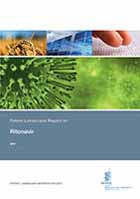Patent Landscape Report on Ritonavir
Publication year: 2011
DOI: English

This report is dedicated to Ritonavir – an antiretroviral drug used to treat HIV infection and AIDS. A major goal of the report is to highlight the technology timeline for Ritonavir from the first filing of this compound to the present filings. It identifies a number of innovation tracks derived from the first Ritonavir patent document. The report also includes an analysis of statistical trends. A comprehensive explanation of the search methodology and history (including all search queries), and of the evaluation of the search results is included and illustrates how patent information can be retrieved and exploited in the area of pharmaceuticals.
- Topic: Public health
- Cooperation partners: Medicines Patent Pool; UNITAID
Ritonavir is an antiretroviral drug from the protease inhibitor class used to treat HIV infection and AIDS. Ritonavir is included in the WHO Model List of Essential Medicines.
A major goal of this report is to highlight the technology timeline for Ritonavir from the first filing of this compound in July 1994 by Abbott Laboratories (WO1994014426) to the present filings in which additional patent families attempt to protect subsequent innovations to the compound, variants and derivatives, combinations with other chemicals, methods of production, methods of use, etc.
The analysis of the researched patent documents showed that filings related to Ritonavir have increased dramatically since the initial disclosure and now include over 800 patent families.
This report identifies a number of innovation tracks that spun-off of the first Ritonavir patent document. They are related to liquid dosage formulations, solid dosage formulations, synthesis of Ritonavir and its key intermediates, polymorphs and crystalline Ritonavir, as well as prodrugs of Ritonavir. These innovation tracks illustrate the continuation of important protection related to Ritonavir as subsequent generations of patents continue to narrow the scope of protection while still maintaining protection from the first Ritonavir patent, a phenomenon that is also sometimes termed 'evergreening'.
The reports also includes an analysis of statistical trends, e.g., 45% of the patent families have a patent grant as family member, and 90% of the families include a PCT application.
A comprehensive explanation of the search methodology and history (including all search queries), and of the evaluation of the search results is included and illustrates how patent information can be retrieved and exploited in the area of pharmaceuticals.
The searchable and sortable patent database includes all 805 patent families, relevant bibliographic data and some added information, e.g. whether the family relates to prodrugs. Each family is linked to the Espacenet database of the European Patent Office which enables verification of the INPADOC family information and related legal status of family members. The database is complemented by a visualization of various statistical analyses of the collection of 805 patent families.